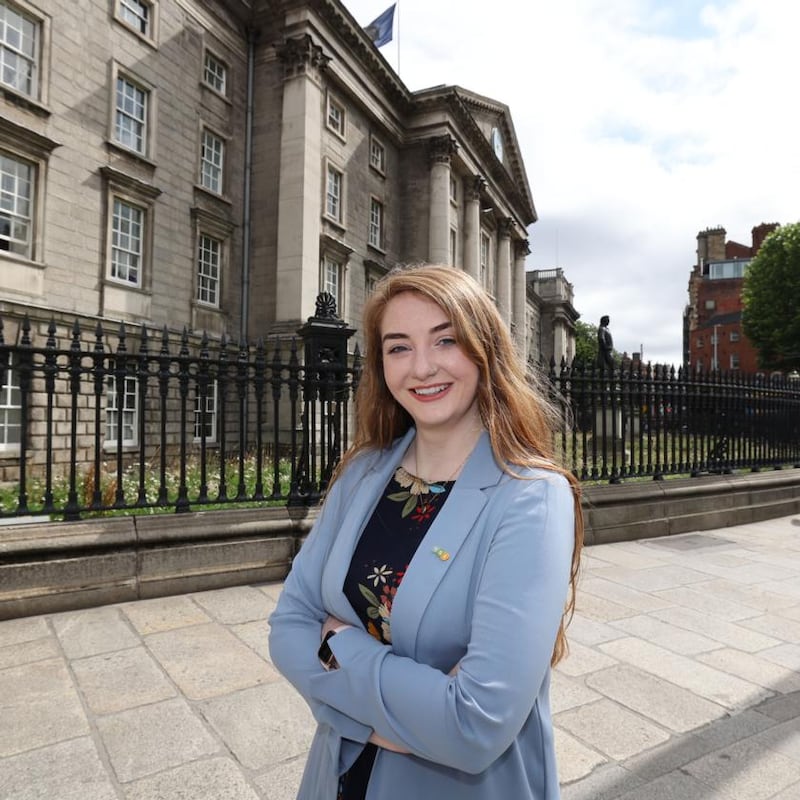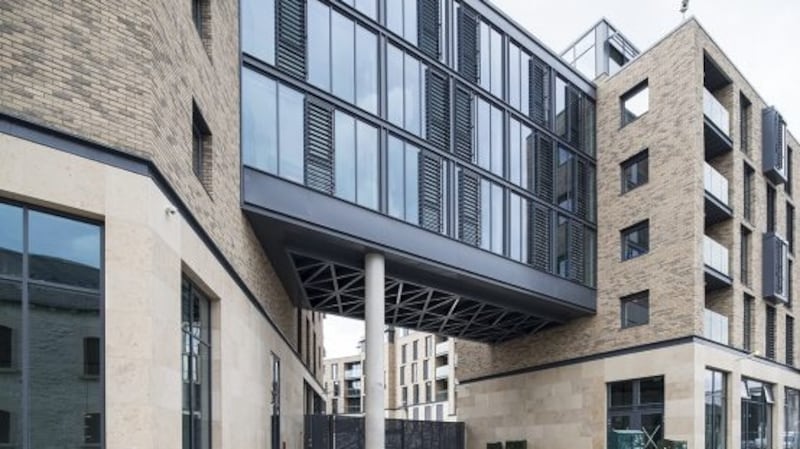In the last five years Dublin has seen a proliferation of a type of accommodation common in other parts of the world but previously largely unseen in Ireland: privately-owned purpose-build student accommodation (PBSAs).
These developments were facilitated by guidelines in the Dublin City Development Plan in 2016 that allowed for a form of student co-living with private bedrooms but shared kitchens and other amenities. Far from the bedsits and shared houses of old, these are often pitched as luxurious facilities with support staff onsite and pool tables and cinema rooms.
In 2019 there were 44 PBSA sites operating, in construction or with planning permission between the canals of Dublin. PBSAs currently constitute between 9,000 and 10,000 beds in the city. These are under the aegis of a handful of operators, most notably Global Student Accommodation (GSA), who operate under the Uninest brand, and Hines, who operate as Aparto.
Highly lucrative, at least in theory, these developments have proven controversial, with some critics arguing that they are over-concentrated in some areas of the city and displace other types of needed development.
Their apparent profitability took a clear fall during the pandemic when their client base disappeared (several providers attempted to retain entire terms worth of prepaid rent but new legislation forbids these operators from requesting more than a month’s rent in advance). Now there are even more question marks over their future.
The development of this form of accommodation came in direct response to apparent need.
"We got representations from government and from HEA [Higher Education Authority] which pointed out that there were 80,000 students in third-level institutions in Dublin, and that we should be promoting Dublin as a student city like Edinburgh and Groningen," says John O'Hara, city planning officer with Dublin City Council.
“I, as the chief planner here, thought that was a good idea. So we put policies in the current Development Plan [2016]to promote purpose-built student accommodation... After the recession we still had a lot of brownfield land, particularly in the inner city and Dublin 8 area and the Liberties area and around Summerhill that had been laying idle and underutilised for 20 or 30 years.”
It was also a response to the housing crisis, he says. “We thought if there were purpose-built student accommodation that it would take students out of the private rented sector.”
Whether it achieved the latter is a matter of debate.
There is definitely a need for student accommodation in Irish cities, but Clare Austick, president of the Union of Students of Ireland, says most of the newly-built PBSA facilities are not addressing that shortfall.

She adds that at this time of year welfare officers across the country are very busy helping students find somewhere to live. She refers to purpose-built student accommodation as “luxury student accommodation” and she says that it’s priced beyond the reach of most students.
According to an EY report carried out for Dublin City Council in 2019, PBSAs are priced higher than the average student rent, at €250 per week as opposed to the €197 per week paid by the average student at that time (though the report also notes the PBSA rent includes all bills).
“Students don’t want luxury purpose-built student accommodation,” she says. “All they really want is for a place to stay that’s adequate, that has space, that has a bed, that allows them to be able to do their study, and they want it to be affordable. Developers coming in and building luxury student accommodation is not what students want…The majority of students don’t want to pay that much for accommodation.”
Analysts seemed to take simple statistics about the numbers of students going to college here without really looking at the culture of how our students tend to live or how much they're willing to pay
She would prefer to see capital grants given to universities to build more of their own accommodation because “the cost of student accommodation, it’s extortionate. [it] definitely is one of the largest barriers that remain in terms of access to third-level education. It’s a huge financial burden on students.”
The extent to which pricing was taken into account when analysing the viability of the PBSA sector is unclear. It’s outside the remit of the planning department. “One of the things we couldn’t take into account in our planning policy was how much it cost,” says O’Hara.
Meanwhile, TU Dublin lecturer and housing analyst Lorcan Sirr believes international operators misread the numbers.
“It’s based on fairly poor analysis of future student housing needs,” he says. “In the UK as soon as people hit 18, they leave home and stay in student accommodation. We tend to have a much more home-based student cohort...The analysts seemed to take simple statistics about the numbers of students going to college here without really looking at the tradition, or the culture of how our students tend to live or how much they’re willing to pay.

“Irish students tend to live along bus corridors and they tend to share houses. Around 40 per cent to 50 per cent of our students come from within the greater Dublin area or from Louth to Wicklow, so they commute in and out. And outside that they tend to get accommodation through local contacts at home… The purpose-built student accommodation [plans] appeared to ignore the cultural component about the future demand from Irish students in particular…That’s how we’ve ended up with so many of these places.”
Indeed, according to the EY report compiled for Dublin City Council in 2019, 79 per cent of the residents of PBSAs are international students.
O’Hara notes that attracting international students was always part of the plan.
Orla Hegarty, assistant professor of architecture, planning and policy in UCD, says such developments have the further effect of raising land values and making forms of lower yield investment in the same areas unviable.
“If you set a standard that the smallest permanent housing unit is a one bedroom apartment of 50sq m, well then the market adjusts around it. People will pay say €1,000 or €1,500 a month for that and then that factors into the land value and property values, and it keeps the market at that level and dampens property speculation… If you suddenly say that 12sq m is a home and that’s €1,000 a month and three of those fit into a 50sq m one bedroom apartment, that leads to higher land values.”
Sirr agrees with this analysis and says that high-yield ventures like PBSAs make other forms of accommodation seem unattractive to profit-hungry investors.
“This is why you get a proliferation of [PBSAS]in a very close radius in parts of Dublin. They drive land values and it just excludes anybody who wants to come in and build housing or apartments for sale or rent because they can’t afford to pay the high prices that the site owners are demanding.”
There has been some acknowledgement of the danger of over-concentration by Dublin Council Council since the guidelines first emerged.
'When you look at the number of students we have and the number of students we are going to have in 10 years' time there's a huge shortage of purpose-built student accommodation'
“There was a variation to the guidelines a couple of years ago such that any application had to include, in their planning application, all [similar] sites within… a kilometre radius in order to help us assess where there was an over-concentration,” says O’Hara, but he adds later: “What I don’t accept is that if you had kept a brownfield site lying vacant for years and years, a residential [development] would eventually have come along. That hasn’t happened and didn’t happen.”
Ronan Lyons, associate professor of economics at Trinity College, also believes the PBSAs are being unfairly maligned. "I think that some of the ire around them is because some people see them as, 'well, this is just capital looking to get around the rules and they're building these new student beds.'
“But when you take a step back and look at the number of students we have and the number of students we are going to have in 10 years’ time there’s a huge shortage of purpose-built student accommodation. We’re really relying quite a bit on the transport system rather than the housing system to make higher education work.”
He agrees that many PBSA rooms are probably too costly for the average Irish student at present, but he puts that price down to high construction costs and believes that if more facilities come on stream they will eventually be more competitively priced.
He rejects the idea that developers have been artificially deflected from other forms of accommodation.
“The reason developers wanted to build student accommodation so much, and the reason they were willing to outbid apartments or houses on a particular site, is because there was a chronic under-supply of student accommodation and because the viability of the costs were a little bit lower for student accommodation than for other apartments. You can solve that not by banning student accommodation [but] by reducing construction costs – making the construction sector more efficient.”
Labour senator Marie Sherlock sees PBSAs, co-living and build-to-rent apartments as all part of the same recurring problem – policies that permit smaller, lower-spec housing units which become instantly more financially attractive to developers than creating sustainable family homes.
“We have an ongoing challenge in the Dublin central area where I’m based in that we’ve had a huge concentration of build-to-rent, co-living and student accommodation. Within large-scale developments we have about 4,800 [such] units that are either under construction or going through the planning system. And you compare that with about 2,500 conventional apartments [and] that gives you a sense of just how skewed development is in Dublin at the moment.”
An over-concentration of such housing, she believes, is hugely damaging to community cohesion due to the transient nature of the people who live there.
As of November 2020, co-living has been essentially banned, but Sherlock says that a number of developers managed to get planning permission for co-living facilities before that.
She also fears that many of PBSAs in the area are destined to become “co-living by the backdoor” if they prove to be unsustainable as student accommodation. (Hegarty also uses the phrase “co-living by the backdoor”).
Sherlock says there has been a pattern/have been instances of the council and an Bord Pleanála facilitating PBSA operators when they requested temporary change-of-use planning permission to allow non-student short-term lets over the course of the pandemic. At least one of these change of use requests, she notes, was in November 2019 before the pandemic (the owners in that case argued that the scheme had been completed too late to benefit from the academic year).
Over time Sherlock fears such changes could become permanent. She points to 611 units in the area with planning permission for short-term lets until September; 663 with permission for short-term lets until next May; and a further 324 awaiting a planning decision.
“Effectively we see the student accommodation operators trying to exploit the planning system for their short-term needs. Just because businesses don’t work out you shouldn’t necessarily be able to apply for planning permission to change the use of a building to something else.”
Hines and GSA run some of the properties referred to by Sherlock. Both were contacted for comment for this article. Hines hadn’t responded to our questions at the time of writing.
A statement from GSA says: “We are not back to pre-pandemic levels, however demand remains robust with strong interest for our Dublin and Cork locations. Bookings have exceeded expectations for the year and are 25 per cent ahead of the same time last year, with some properties across the country already fully booked.”
Regarding change of use applications they said: “With the uncertainty earlier this year on the return to in-person teaching, GSA sought temporary flexibility through a change of use application for Ardcairn House and Dominick Place in Dublin, and Lee Point in Cork. With students returning and bookings exceeding expectations for this academic year we anticipate very little, if any alternative use across these prime locations.”
'There's huge money internationally in property investment and it has just captured policy to a large extent'
This is ultimately a story about development trends. John O’Hara says that the appetite for building PBSAs seems to have died down with very few recent applications, this despite the 2019 EY report anticipating a need for 13,000 to 14,000 PBSA beds by 2024, with an eventual need for 50,000.
“I can’t discern whether it’s a result of the Covid pandemic or saturation [of the market],” he says.
Build-to-rent is “the majority of apartment typology in Dublin at the moment”, he says. Later he says: “It was never our intention that when we promoted apartment living in the city that there would be so much build-to-rent.”
In turn critics have moved their worries about an oversaturation of PBSA sites to a concern about an oversaturation of build-to-rent properties. Orla Hegarty fears that all such policies ultimately speak to the interests of developers rather than the needs of the people. “There’s huge money internationally in property investment,” she says. “And it has just captured policy to a large extent.”
O’Hara rejects this, but he does pinpoint a reality that seems baked into the country’s dependence on large international operators to achieve our development goals.
“What we’re looking to promote in the city is the mixed-use approach, the 15-minute city, where all those good things that make up a city, the vitality and variety in the city, are all of equal weight, rather than one use prevailing at the expense of other uses for five years and then there’s a total switch to the other,” he says. “That’s my personal concern. There’s a swingometer going from one dominant use to another rather than taking a middle road and getting a mixture of uses.


















